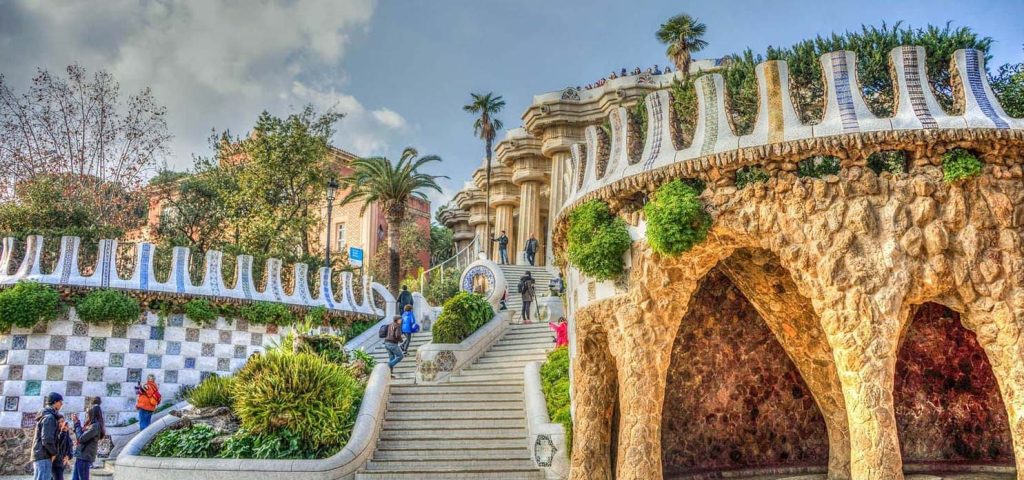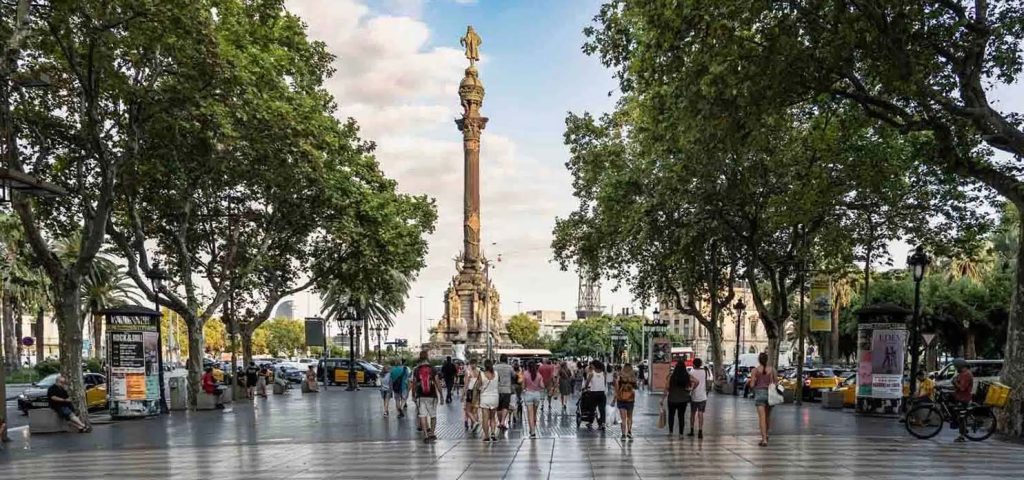Barcelona, a city steeped in history and brimming with architectural wonders, beckons travelers from around the globe with its rich cultural tapestry and Mediterranean charm.
My journey through Barcelona’s iconic landmarks was nothing short of awe-inspiring. I will share the experience of my journey in the heart of Catalonia, exploring the must-visit tourist attractions that define this dynamic metropolis.
1. Sagrada Família – Gaudí’s Unfinished Masterpiece
How to Get There:
The Sagrada Família is easily accessible by metro (L2 and L5 lines, Sagrada Família station) or by bus. From Plaça de Catalunya, take the L2 line towards Badalona Pompeu Fabra or the L5 line towards Horta.
Highlights:
The Sagrada Família, Antoni Gaudí’s visionary basilica, is an architectural marvel that defies convention. Its towering spires and intricate façades are adorned with symbolic sculptures and colorful stained glass windows that bathe the interior in ethereal light.
Ticket Price:
Tickets start at €20 for basic admission, with options for guided tours and access to the towers available for additional fees.
Recommendation:
Visiting the Sagrada Família was a transformative experience. The interplay of light and space inside the basilica is breathtaking, and every corner reveals Gaudí’s meticulous attention to detail. I recommend purchasing tickets online in advance to skip the long queues and opting for the audio guide to fully appreciate the symbolism embedded in Gaudí’s design.
2. Park Güell – Gaudí’s Playground of Imagination
How to Get There:
Take the metro (L3 line, Vallcarca or Lesseps stations) followed by a short walk uphill to Park Güell. Alternatively, buses 24, 31, 32, and H6 also stop near the park entrance.

Highlights:
Park Güell is a whimsical public park designed by Antoni Gaudí, characterized by its mosaic sculptures, colorful tiled benches, and fantastical architecture. The park offers panoramic views of Barcelona and houses Gaudí’s former residence, now a museum.
Ticket Price:
Entry to the monumental zone (including the main attractions) is €10 per person. Booking tickets online in advance is recommended, especially during peak tourist seasons.
Recommendation:
Exploring Park Güell felt like entering a fairytale realm. The organic forms and vibrant colors of Gaudí’s designs harmonize with the natural landscape, creating a serene yet surreal atmosphere. I suggest visiting early in the morning or late in the afternoon to enjoy the park’s tranquility and capture stunning photos of Barcelona’s skyline from the park’s high vantage points.
3. La Sagrada Família- Gaudí’s Unfinished Masterpiece
How to Get There:
The Sagrada Família is easily accessible by metro (L2 and L5 lines, Sagrada Família station) or by bus. From Plaça de Catalunya, take the L2 line towards Badalona Pompeu Fabra or the L5 line towards Horta.
Highlights:
The Sagrada Família, Antoni Gaudí’s visionary basilica, is an architectural marvel that defies convention. Its towering spires and intricate façades are adorned with symbolic sculptures and colorful stained glass windows that bathe the interior in ethereal light.
Ticket Price:
Tickets start at €20 for basic admission, with options for guided tours and access to the towers available for additional fees.
Recommendation:
Visiting the Sagrada Família was a transformative experience. The interplay of light and space inside the basilica is breathtaking, and every corner reveals Gaudí’s meticulous attention to detail. I recommend purchasing tickets online in advance to skip the long queues and opting for the audio guide to fully appreciate the symbolism embedded in Gaudí’s design.
4. Park Güell- Gaudí’s Playground of Imagination
How to Get There:
Take the metro (L3 line, Vallcarca or Lesseps stations) followed by a short walk uphill to Park Güell. Alternatively, buses 24, 31, 32, and H6 also stop near the park entrance.
Highlights:
Park Güell is a whimsical public park designed by Antoni Gaudí, characterized by its mosaic sculptures, colorful tiled benches, and fantastical architecture. The park offers panoramic views of Barcelona and houses Gaudí’s former residence, now a museum.
Ticket Price:
Entry to the monumental zone (including the main attractions) is €10 per person. Booking tickets online in advance is recommended, especially during peak tourist seasons.
Recommendation:
Exploring Park Güell felt like entering a fairytale realm. The organic forms and vibrant colors of Gaudí’s designs harmonize with the natural landscape, creating a serene yet surreal atmosphere. I suggest visiting early in the morning or late in the afternoon to enjoy the park’s tranquility and capture stunning photos of Barcelona’s skyline from the park’s high vantage points.
5. La Rambla – Barcelona’s Iconic Boulevard
How to Get There:
La Rambla stretches from Plaça de Catalunya to the Columbus Monument at Port Vell. It’s within walking distance from many central neighborhoods, or accessible via metro (L3 line, Liceu or Drassanes stations).

Highlights:
La Rambla is a bustling boulevard lined with shops, cafes, street performers, and historic landmarks like the Liceu Theatre. It’s a hub of activity day and night, offering a glimpse into Barcelona’s lively street culture.
Recommendation:
Strolling down La Rambla was a sensory delight, with the lively atmosphere and diverse array of street vendors selling everything from souvenirs to freshly squeezed juices. While it can be crowded, exploring the side alleys (like Carrer de Petritxol for chocolate lovers) provides quieter retreats. I recommend visiting early in the morning or late evening to experience its charm without the throngs of tourists.
6. Barri Gòtic – The Gothic Quarter
How to Get There:
The Gothic Quarter is located in Barcelona’s old city center. It’s easily accessible on foot from La Rambla or via metro (L4 line, Jaume I or Liceu stations).
Highlights:
Barri Gòtic is a labyrinthine neighborhood steeped in medieval history, boasting narrow cobblestone streets, ancient churches (like the Barcelona Cathedral), and quaint squares like Plaça Reial.
Recommendation:
Wandering through Barri Gòtic felt like stepping back in time, with each alleyway revealing hidden treasures like artisan shops and centuries-old architecture. I particularly enjoyed visiting the Barcelona Cathedral and exploring the atmospheric Plaça del Pi. For a deeper dive into its history, joining a guided walking tour enhanced my understanding of this historic quarter’s significance.
7. Casa Batlló – Gaudí’s Architectural Fantasy
How to Get There:
Casa Batlló is centrally located on Passeig de Gràcia, easily accessible by metro (L2, L3, and L4 lines, Passeig de Gràcia station) or by bus. It’s within walking distance from Plaça de Catalunya.
Highlights:
Casa Batlló is a prime example of Antoni Gaudí’s innovative architecture, characterized by its organic shapes, colorful mosaic façade, and whimsical interior design. The rooftop terrace offers panoramic views of Barcelona.
Ticket Price:
Standard tickets start around €29 for adults, with options for audio guides and virtual reality tours available at additional cost.
Recommendation:
Exploring Casa Batlló was like stepping into a surrealist dream. The fluid lines and intricate details of Gaudí’s design evoke a sense of wonder and creativity. I recommend purchasing tickets online in advance to skip the lines and maximize your time inside. Don’t miss the rooftop terrace for stunning views of Barcelona’s urban landscape.
8. Montjuïc – Hill of Museums and Panoramic Views
How to Get There:
Montjuïc is accessible by cable car from the Montjuïc Funicular (Paral·lel metro station) or by bus (lines D20, 55, 150). It’s also within walking distance from Plaça d’Espanya.

Highlights:
Montjuïc is a historic hill overlooking Barcelona, home to several museums including the Museu Nacional d’Art de Catalunya (MNAC) and the Fundació Joan Miró. The Magic Fountain of Montjuïc offers spectacular evening light and water shows.
Recommendation:
Exploring Montjuïc is a cultural and scenic delight. Whether visiting museums, strolling through gardens, or catching a sunset at the Mirador del Migdia viewpoint, Montjuïc offers something for everyone. I recommend taking the cable car for panoramic views of Barcelona and enjoying the Magic Fountain show in the evening, a mesmerizing display of music, light, and water.
9. La Boqueria Market – Culinary Delights in the Heart of Barcelona
How to Get There:
Located directly off La Rambla, La Boqueria Market is easily accessible by metro (L3 line, Liceu station) or by walking from Plaça de Catalunya.
Highlights:
La Boqueria Market is Barcelona’s most famous food market, offering a feast for the senses with its colorful array of fresh produce, seafood, meats, cheeses, and local delicacies. It’s a paradise for food enthusiasts and photographers alike.
Recommendation:
Visiting La Boqueria Market was a culinary adventure. Sampling fresh fruits, enjoying a seafood lunch at one of the market’s bars, and interacting with local vendors provided a glimpse into Barcelona’s gastronomic culture. I suggest visiting in the morning to experience the market at its liveliest and to avoid the midday crowds.
10. Palau de la Música Catalana – Jewel of Modernist Architecture
How to Get There:
Palau de la Música Catalana is located in the El Born neighborhood, accessible by metro (L1, L4 lines, Urquinaona or Jaume I stations) or by walking from La Rambla.
Highlights:
Palau de la Música Catalana is a stunning example of Catalan modernist architecture, designed by Lluís Domènech i Montaner. Its vibrant façade and lavish interior, including the stained glass skylight and sculptural columns, make it a UNESCO World Heritage site.
Ticket Price:
Guided tours start at €20 per person, with concerts and special events offering additional experiences.
Recommendation:
Attending a concert or taking a guided tour of Palau de la Música Catalana was a highlight of my visit to Barcelona. The building’s acoustics and visual splendor create an immersive experience that celebrates Catalan culture and music. I recommend booking tickets in advance for a guided tour to fully appreciate the intricate details and history behind this architectural gem.
Barcelona’s iconic landmarks embody the city’s rich history, artistic genius, and vibrant culture. Each site—from Gaudí’s architectural wonders like the Sagrada Família and Park Güell to the lively boulevards of La Rambla and the historic charm of Barri Gòtic—offers a unique glimpse into Catalonia’s past and present.